Research
By: Crystal Mackay, MA‘05
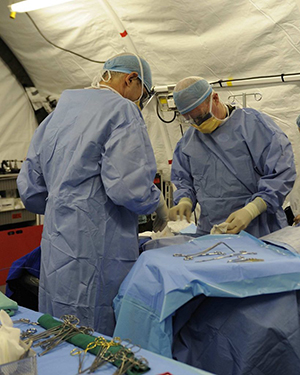 Dr. Vivian McAlister at field hospital.
Dr. Vivian McAlister at field hospital.
Antipersonnel Improvised Explosive Devices (IEDs) are thought to cause the worst survivable injury ever seen in war.
These often crudely constructed bombs contain an explosive, a detonator and small objects like nails, ball bearings and even rocks meant to cause severe wounds. Their use in modern warfare, most notably in the conflicts in Iraq and Afghanistan, are of deep concern to those on the frontlines treating wounded soldiers and civilians.
“Improvised Explosive Devices target an individual with the aim of causing maximal injury,” said Dr. Vivian McAlister. “In all my years as a surgeon, the Improvised Explosive Device was the worst thing I’ve ever seen. What we saw was horrific.”
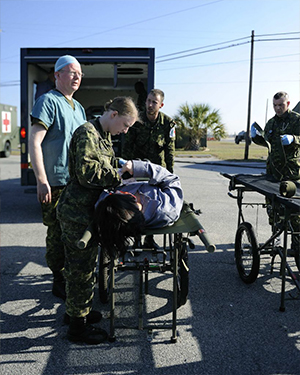 Dr. Vivian McAlister on deployment overseas.
Dr. Vivian McAlister on deployment overseas.
After volunteering as a civilian surgeon for the Afghan mission in 2006, Dr. McAlister, a Professor in the Department of Surgery, went on to join the Canadian Armed Forces at the age of 52 and returned another five times as one of a team of military trauma surgeons working on the Kandahar Airbase during the conflict in Afghanistan.
The extent of destruction he saw and the helplessness he felt compelled him to begin researching the injury patterns caused by IEDs and the best way to treat related injuries. Along with Surgery Fellow Dr. Shane Smith and Adjunct Faculty Member Dr. Rich Hilsden, Dr. McAlister began collecting data on IED-related injury.
Drs. McAlister and Smith published a study in BMJ Open that characterized the extent of these injuries and compared the injury pattern to that of conventional landmines. Landmines, which were designed to maim and injure rather than kill, have been deemed to be indiscriminate weapons, and 162 countries signed the 1997 Ottawa Treaty pledging to stop their production and use. Dr. McAlister and his team documented that the injury pattern from IEDs was considerably worse than landmines.
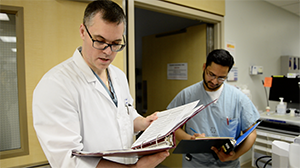 Dr. Shane Smith on rounds.
Dr. Shane Smith on rounds.
“We wanted to document how this dreadful weapon injures humans. In conflict, you are allowed to try to immobilize your enemy to prevent them from doing something or to complete your mission. But the one thing you are not at allowed to do is cause unnecessary pain and suffering, and we showed that’s what Improvised Explosive Devices do,” Dr. McAlister said. “That was an important reason to document these injuries, but we also wanted to develop better responses to the injury in order to save a person’s life.”
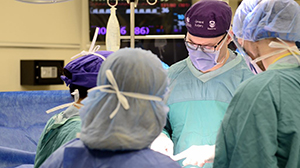 Dr. Shane Smith in the operating room in London, ON.
Dr. Shane Smith in the operating room in London, ON.
The study was the first piece of the puzzle in moving forward with clinical research in this area. The team is now looking at the injury patterns in modern combat in order to determine how to better treat them.
“By having a good description of how people are being injured, it allows surgeons to better prepare, it allows us to develop better approaches to treating these patients and to develop better body armour and treatment tools,” said Dr. Smith.
Often when a soldier or civilian is injured in combat, before they can be evacuated, the first priority is to win the battle. This often means medics have to provide treatment in the combat zone before the patient can be moved to hospital for surgery.
Drs. Smith and Hilsden are looking at the use of two specialized devices to improve point of injury care on the battlefield, with the aim of stopping bleeding and preventing life-threatening complications from developing.
“Our current research focuses on injuries where the arm or leg meets the torso – injuries that are common with improved explosive devices. Our immediate questions revolve around the best way to manage those injuries outside of the hospital setting,” said Dr. Hilsden.
A Resuscitative Endovascular Balloon Occlusion of the Aorta (REBOA) is a device typically used in a hospital setting to block the aorta and stop lower abdominal bleeding.
“If you are going to send soldiers into harm’s way, if you are going to put a solider in a place where he or she can be injured, you really have a responsibility to provide them with the best care that you can at the point of injury and afterward.” — Dr. Shane Smith
The team from Schulich Medicine & Dentistry is finding ways to improve the device to be easier to use, safer, and less likely to be knocked out of place when used in a more austere environment. Their proof of concept study demonstrated that it could be used in a combat situation to control bleeding.
Similarly, they are looking at a device called a junctional tourniquet that is applied externally to block the blood flow up toward the torso. The team is developing protocols and algorithms on how to use these devices effectively in combat situations, and are designing experiments to show whether these devices will hold up when the patient has to be moved or evacuated from the frontlines.
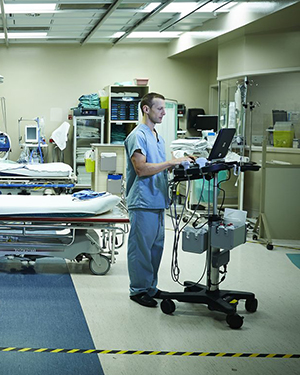 Dr. Rich Hilsden in London, ON.
Dr. Rich Hilsden in London, ON.
Dr. Hilsden has been in the military for 16 years and is part of the mobile surgical resuscitation team, which can deploy surgical infrastructure rapidly to create surgical environments where none exist. He treated patients overseas in both Iraq and Afghanistan.
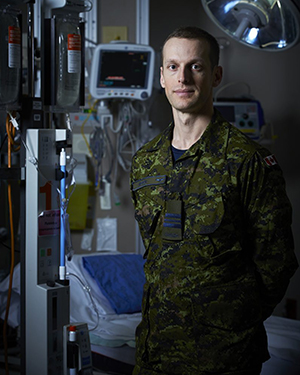 Dr. Rich Hilsden
Dr. Rich Hilsden
Dr. Richard Hilsden photo credit: Nation Wong
“Seeing these young people face these types of injuries is really hard,” said Dr. Hilsden. “It’s a very emotionally taxing experience, but this is the reality you face as a professional military surgeon.
“It’s the scientist in me that keeps me going. Being able to contribute to improving care.”
Dr. Raymond Kao was a member of the Canadian Armed Forces beginning when he was 17 years old. He was an Internal Medicine and Critical Care physician in the Canadian Navy and is a Professor at Schulich Medicine & Dentistry. He was the School’s first Chair in Military Critical Care Research.
“All the research questions originate on the battlefront. We then bring those back home, and try to answer them,” he said. “Military physicians have to anticipate what type of injury is going to occur, it provides focus and encourages the researchers to ask the right questions.”
And it’s the drive to improve care that inspires Dr. McAlister as well. He says clinical research and the military mindset go hand in hand. In both cases, the aim is to outwit the antagonist. “That’s true for our combat soldiers,” he explained. “But the medical personnel also take it on. How are we going to outwit the new types of injuries?”
For Dr. Curtis Van Doormaal, an anesthesia resident at Schulich Medicine & Dentistry who worked as a physician in support of the Canadian Air Force, simulation training is an important part of the answer to that question.
Using simulation, he developed a new way to teach residents to insert chest tubes, which is a core trauma procedure skill that is part of tactical combat casualty care. He says medical education is central to improving care and reducing complications on the battlefield.
“This kind of research helps us to ensure that we get the same standard of care in the middle of the desert in Kuwait as we would expect here in Canada,” Dr. Van Doormaal said.
“This work directly impacts the patients I dealt with in Afghanistan and it directly impacts my friends and colleagues who are going on future deployments,” added Dr. Smith. “If you are going to send soldiers into harm’s way, if you are going to put a solider in a place where he or she can be injured, you really have a responsibility to provide them with the best care that you can at the point of injury and afterward.”
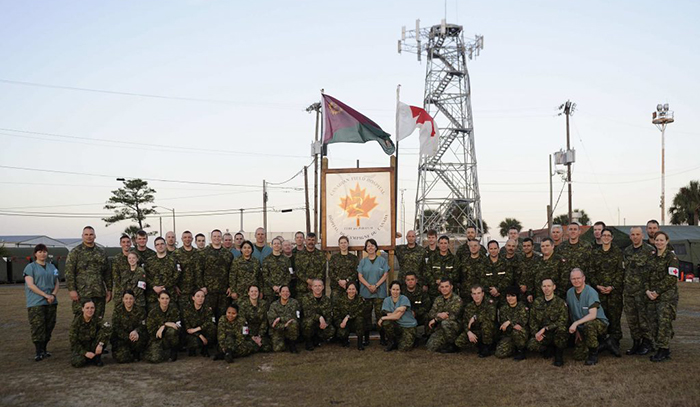 Dr. McAlister on deployment (first row, far right).
Dr. McAlister on deployment (first row, far right).








